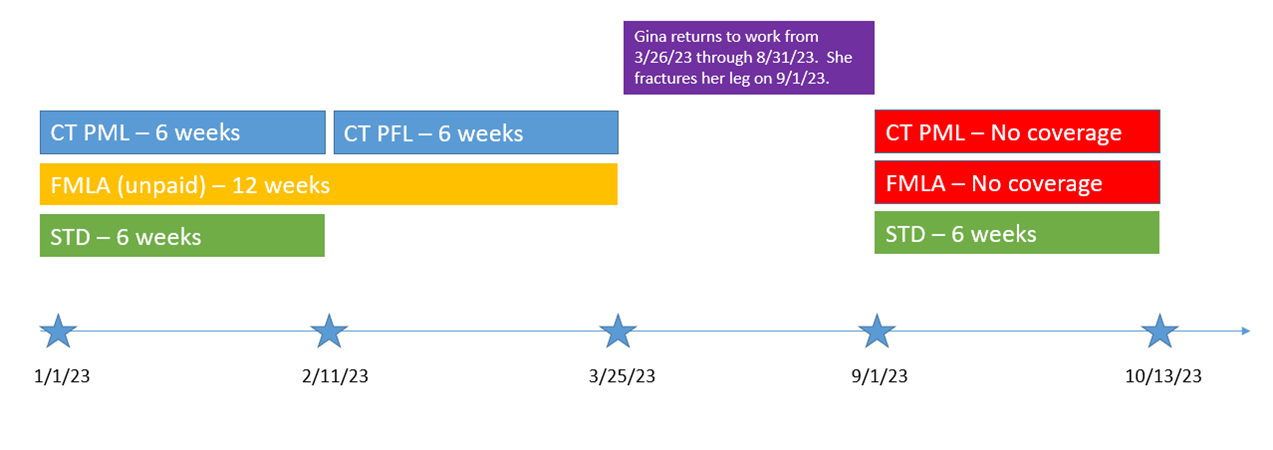by Rebecca Ford, Esq. - Product Director - Reliance Matrix
& Margaret Reid - Product Director - Reliance Matrix,
April 04, 2024
 As states continue to implement paid leave programs, more employers are asking whether Short Term Disability (STD) coverage still offers value to employees covered under a mandatory statutory paid leave program. Do employees really need both? The answer is yes, and we're here to tell you why. We promise, no quizzes at the end.
As states continue to implement paid leave programs, more employers are asking whether Short Term Disability (STD) coverage still offers value to employees covered under a mandatory statutory paid leave program. Do employees really need both? The answer is yes, and we're here to tell you why. We promise, no quizzes at the end.
What's the Deal? Aren't the Two the Same?
No! Statutory paid leave programs, which include paid family and medical leave programs, include two components: paid medical leave (PML), which is leave for an employee's own medical condition, and paid family leave (PFL), which applies when an employee takes leave to bond with children or to care for someone else. While the PML portion of most paid family and medical leave programs is similar to STD coverage because it provides a portion of income replacement when leave is taken for an employee's own serious health condition, PML and STD are not created equal.
Before you get ready to kick your STD coverage to the curb, consider these factors:
- Do you have employees working in states with mandatory statutory paid leave programs? Or even more importantly, do you have some employees that work in states with mandatory statutory paid leave program and some who work in states that don't?
- Do you have a wide range of employee salaries at your company?
- Do you see common trends in your employees' leaves (e.g. intermittent leaves, return to work ramp-up plans, multiple leaves in one year, etc.)?
These areas all have the potential to create coverage gaps for your employees if you get rid of STD coverage.
Still not convinced? Read on for more about income replacement and duration gaps that often exist in statutory leave programs and how an STD plan can fill those gaps. We'll also share some information about unique STD plan features that really matter to your employees, like return to work rehabilitative support.
Percentage of Income Replacement
While PML and STD both provide income replacement for an employee's own serious health condition, one big difference is the portion of income replaced. Most STD plans offer straight income replacement based upon a percentage of income (typically 60% to 70%) up to a maximum benefit, while PFML programs tend to provide a tiered benefit, which replaces income based on a percentage depending on an employee's average weekly wage. This allows lower wage earners to receive a larger portion of overall income replacement and higher wage earners typically receive a lower portion since they typically then cap out at the maximum benefit.
For example, the Oregon Paid Family and Medical Leave (OR PFML) program pays 100% income replace to employees earning 65% or less than the state average weekly wage (SAWW). Employees who make more than 65% of the SAWW get 65% of the SAWW plus 50% of their average weekly wage that's over the 65% of the SAWW. This sounds like a lot, but the maximum benefit is $1,523.63.
Time out! All right, we know you weren't expecting to do math today. So what does this actually mean? It means that some employees receive almost their full average weekly wage, but employees who earn more than $1,523.63 per week (maximum benefit) will receive much less. One way employers can help their employees get closer to their average weekly salary is to offer STD plans that pay concurrently with a statutory paid leave plan.
Most STD and statutory paid leave plans account for concurrent leave payments and do not allow employees to earn more than their average weekly income. However, if an employee receives STD while receiving a PML benefit under a statutory paid leave plan, even with the offset, they would receive a higher portion of income replacement than with the PML benefit alone.
Durations for Statutory Leave Plans vs. STD and Why It Matters To You
While statutory paid leave programs vary, they tend to provide leave durations in two ways: a set leave duration maximum for each leave type or a maximum leave duration for all leave reasons.
For example, the Massachusetts PFML (MA PFML) program allots a set leave duration for each leave type. PFL for bonding gets 12 weeks while PML gets 20 weeks. When leave types are taken within the same benefit year (for a combination of leave reasons), there is a 26-week maximum duration.
The Connecticut PFML (CT PFML) program provides one bucket of 12 weeks maximum across all leave reasons and when used in combination. However, in Connecticut, additional time is available for employees who experience a serious health condition during pregnancy. Once employees reach their maximum duration of leave, the bucket is empty, and they cannot take any additional paid leave for the benefit year. In contrast, STD plans reset for each independent condition.
If you have employees who need to take multiple periods of leave within a given year, those who have statutory paid leave coverage would be limited in the amount of time per year; however, if they also had STD, their STD allotment would reset for each new medical condition.
If you're like us, examples help. So here you go!
Gina is a nurse who has CT PFML coverage and does not have STD coverage. She delivers a baby via vaginal delivery and goes out on leave under CT PFML on Jan. 1, 2023. She is certified for six weeks of CT PML leave and does not require the additional PML for her pregnancy. She also takes six weeks of CT PFL to bond with the baby, which means there is no additional CT PFML leave left for the remainder of the year. Later that same year, Gina breaks her leg and requires surgery with a recovery period of six weeks. While Gina's absence from work may be protected by federal and state unpaid leave absence laws (e.g., FMLA, CT FMLA), she does not have access to paid leave under the CT PFML program. In this scenario, if Gina had STD coverage, she would be able to use it as these plans reset for each independent condition.

What Else Makes Having Both Important? Work Rehabilitation and Value-Added Services
Unlike statutory paid leave, STD plans often include return-to-work rehabilitation support, return-to-work accommodation support, dependent care reimbursement, and work incentive benefits. These product features help support your employee's return to work after a medical leave. Some carriers also offer value-added services on their STD plans, which can include employee assistance programs, travel assistance, financial wellness, and/or identity theft protection. Statutory paid leave programs do not have these types of programs and services.
What Do I Do Now?
Keeping STD plans in place even if employees work in states with statutory paid leave programs ensures coverage for all approved medical needs. And that type of employee support matters. A growing number of studies show that comprehensive paid leave programs attract and retain talented employees.
Comparing available coverage helps identify gaps so employers can make informed decisions and can communicate their investments in ways that help employees understand their benefits because while the PML portion of statutory paid leave programs is similar to STD, the programs are not created equal.
Reliance Matrix Can Help!
Through its insurance and administrative services entities, Reliance Matrix offers integrated leave management services including short-term disability products. Product features and availability may vary by state. For more information, please contact your Reliance Matrix account manager.
